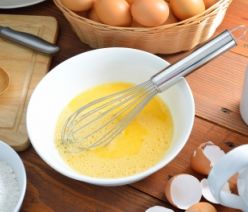A student recently asked me why scrambled eggs tasted different at their friends and relatives houses compared to scrambled  eggs made at home. Great question! I decided to let my students conduct an experiment by preparing scrambled eggs with different liquids in order to discover the effects each had on the eggs’ appearance, taste and texture. Not only did this experimental lab get the students into the kitchen to teach them how to make scrambled eggs, but it was a great way to incorporate a little food science into the curriculum as well!
eggs made at home. Great question! I decided to let my students conduct an experiment by preparing scrambled eggs with different liquids in order to discover the effects each had on the eggs’ appearance, taste and texture. Not only did this experimental lab get the students into the kitchen to teach them how to make scrambled eggs, but it was a great way to incorporate a little food science into the curriculum as well!
Set
- Do all scrambled eggs taste the same? Explain. One ingredient that may have an overall effect on the appearance, taste and texture of scrambled eggs is the liquid used to prepare them.
Materials
- Lab/Experiment Ingredients & Equipment
- Paper Plates (optional)
- Labels (index cards)
Activities
- I divided my class into four groups for this experiment. Each group prepared a different version of scrambled eggs. The group categories included: eggs only, eggs with water, eggs with heavy cream or half and half, and eggs with milk. Note: Teacher will determine the number of eggs used based on class size.
- Each group prepared a label for their eggs and prepared them according to their assigned method.
- After all eggs were cooked, students sampled and descriptively evaluated each type, filling in their chart as they moved from group to group. Students were not permitted to use generic descriptive words such as good, bad, etc.,instead they had to use descriptive adjectives.
- After students cleaned up their kitchens, they completed their follow-up questions. We then discussed their results as well as the science behind the liquid. Students discovered that the purpose of any liquid used in scrambled eggs provides body and flavor as well as adds to the soft texture. Cream provides the richest flavor, while no liquid provides the “eggiest” flavor. The liquid also creates steam giving a lift and fluffiness to the eggs with water yielding the most fluff. Too much liquid in eggs results in runny, watery eggs. Bottom line–use any liquid you have on hand or none at all, but if you are looking for specific appearance, taste or texture characteristics, use the liquid you most prefer.
- Finally, we created a class tally of preferred eggs from this experiment on the board to see which was the class favorite.
Attachments
Extensions
Image Courtesy of Amenic181 of Free Digital Photos

